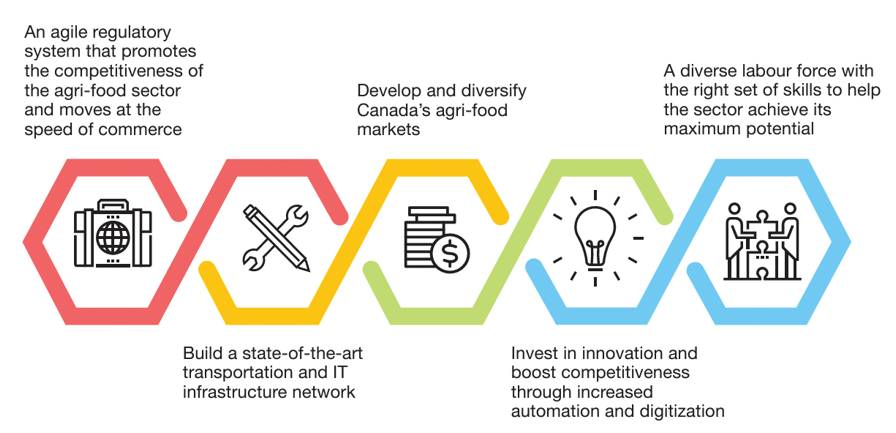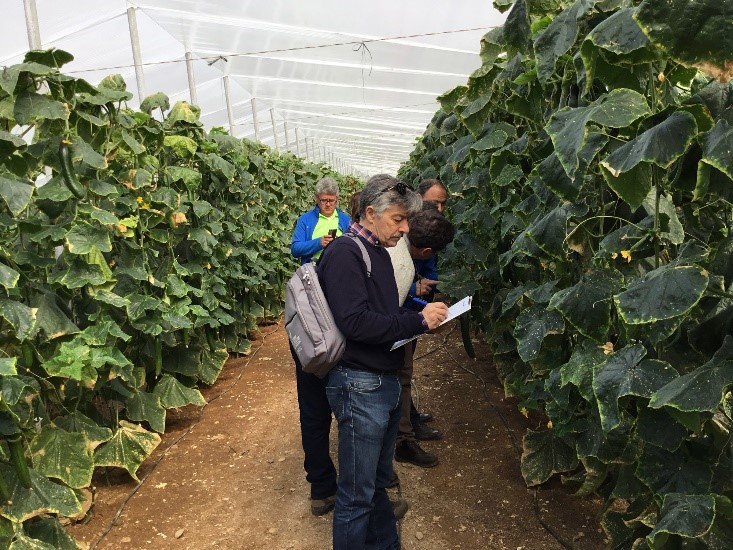Transforming Canada’s Agriculture Sector: A Call for Climate-Smart Policies and Investments
The Canadian farming community is facing multi-pronged challenges of increasing their production, cutting down on emissions and adverse weather at a time when there is a steady reduction in government funding for the sector.
The worry among the community is real.
A recent report by RBC highlights the disparity in support for Canada’s agriculture compared to other leading food-producing nations. Canada lags behind the US, EU, Australia, and China in climate funding for its agriculture sector, despite increasing expectations for higher yields in adverse weather conditions.
Beyond the RBC report, further analysis of comparative data underscores the extent of this gap.
The 2023 federal budget appears to signify a noteworthy commitment, with C$333 million allocated over the next decade to bolster research, product development, and processing capacity within the agriculture and agri-food sectors. However, when assessed alongside its peers, Canada’s dedication to public spending on agricultural research and development (R&D) as a percentage of its agricultural GDP appears lackluster.
The ambitious Inflation Reduction Act from the United States last year embeds US$19.5 billion in incentives and tax credits to support ag-tech, conservation, and other measures. Even earlier, U.S. climate funding as a percentage of total farmers’ revenues stood at 1.7% — more than three times the level in Canada. Similarly, China is revitalizing farmland through an annual US$7 billion investment. The National Strategy for Climate Adaptation, which includes promoting climate-smart agriculture, focuses on agricultural resilience while reducing agricultural emissions. The Common Agricultural Policy (CAP) of the European Union (EU), meanwhile, has lined up €387.9 billion (C$580 billion) for 2021-2027 to support farmers adopting sustainable agriculture and climate-smart practices.
According to OECD data, in 2019, Canada allocated about 0.6% of its agricultural GDP to public agricultural R&D. During the same period, the United States devoted 0.8% of its agricultural GDP to public agricultural R&D, the United Kingdom dedicated 1.8%, and China invested 1.1%. Astonishingly, Canada’s performance was even below the OECD average of 0.8% and the world average of 0.7%!
Addressing this discrepancy isn’t merely about optimizing statistics; it is about securing Canada’s position as a dominant force in agriculture.
According to a report from the Information and Communications Technology Council (ICTC), in addition to climate change and food security issues, Canada’s agri-food sector faces “intense competitive pressures in global and domestic markets.”
Earlier, Canada’s Economic Strategy noted that the agri-food sector requires increased investments in clean agriculture and substantial government support for R&D to compete in a global market adopting new farming technologies, such as vertical farms and smart tech.

Source: Canada’s Economic Strategy
Agriculture accounts for 10% of Canada’s greenhouse gas emissions. It also holds the potential to reduce emissions through initiatives like carbon offsets and no-till farming, which is still a nascent sector with norms and regulations still evolving.
Amid all this, the federal government’s recent goal of a 30% reduction in greenhouse gas emissions associated with fertilizer application by 2030, as part of Canada’s Strengthened Climate Plan, has added complexity. Farmers are concerned about balancing this goal with their efforts to meet global food demand in the face of rising extreme weather events and call for environmental sustainability.
Canada is uniquely placed to lead
Despite the challenges, the Canadian agricultural sector is ahead of the curve in many areas. Ranked among the top 10 food exporters globally, Canada’s food system also earns high sustainability marks on the Food Sustainability Index. Moreover, over 65% of Canadian farmers are said to have implemented practices aimed at fortifying their farms against soil, water, or biodiversity issues. Regions like the Canadian prairies lead the way with decades-long advancements in deploying technologies and sustainable agricultural practices focused on curbing emissions.
For instance, Saskatchewan, troubled by droughts and soil degradation in the 1980s, revitalized its agriculture with innovative methods like zero tillage and diverse crop rotations. By 2016, 93% of cropland acres in the province were under conservation tillage, curbing soil erosion and enhancing water retention, in the process reducing emissions while increasing yields. Shifting to no-till seeding also reduced the need for summer fallow, a practice aimed at conserving soil moisture in semi-arid regions, as reported by Statistics Canada.
The implementation of a diverse crop rotation strategy stands as a cornerstone in rejuvenating and sustaining soil health within Canada’s agricultural sector. The nation has been a trailblazer in introducing novel crop varieties and genetic enhancements, necessitating ongoing investments in these areas. Pulses, including lentils and peas, play a dual role in this narrative by naturally fixing nitrogen, a crucial element for soil fertility, thereby reducing the need for nitrogen fertilizer. The interconnection between the global demand for protein and soil health is exemplified by projects such as the construction of the world’s largest pea processing plant by Roquette in Portage la Prairie, Manitoba.
Another interesting example is the case of Genesis Fertilizers, a partnership of farmers across Western Canada investing in a new urea plant proposed to come up in Saskatchewan. Given its environmental impact, the focus on nitrogen is underscored by efforts to utilize green ammonia in plant construction.
Hurdles in advancing ag innovation
Continued innovation and technology adoption are crucial in addressing agricultural challenges linked to climate change, population growth and global food demand. Achieving top-quality products and advanced equipment necessitates significant financial investment. Government funding is vital to mitigate these risks for both producers and tech startups working on innovations.
High cost of equipment: Consider precision agriculture equipment as an example. Priced upwards of $750,000, these tools for maximizing efficiency remain out of reach for many farmers. Further, there’s a pressing need for comprehensive education among farmers to leverage these machines effectively and optimize their data utilization.
No rewards for early adopters of no-till farming: The new Greenhouse Gas Offset Credit System limits participation in the carbon market to projects launched after January 1, 2017. This creates a barrier for early adopters no-till farming practices. Recognizing and supporting these innovators is crucial to encourage wider adoption of fostering sustainable agriculture.
Lack of advanced soil measurement technology: There are notable concerns regarding data gaps, modeling accuracy, addressing indirect emissions, which are still emerging in scientific understanding, and tackling carbon leakage in agriculture’s emission reduction efforts. A comprehensive Measurement, Reporting, and Verification (MRV) system throughout the value chain is essential for identifying areas for meaningful emission reduction interventions and preserving soil health. Currently, only 20% of North American farmland undergoes testing, with results scattered across various platforms. Traditional soil labs remain the go-to, yet their methods are laborious, expensive, and time-consuming. This reliance on traditional processes limits the rapidity of data acquisition and analysis.
Cost of technology: Cutting-edge technology, including smart sensors and remote sensing via satellites or drones, promises accuracy but comes with a hefty price tag, creating barriers to widespread adoption among farmers.
Access to data: Access to accurate data related to agriculture is pivotal in innovation. Collaborative efforts between governments and tech firms are vital to ensure affordable technology solutions, enhancing efficiency and curbing environmental impact.
The need for coherent policies
A unified federal strategy is crucial for coherent policies, streamlining investments and initiatives, while providing farmers with a clear path toward climate-smart agriculture.
Collaboration with provinces: There’s a pressing need for federal-provincial collaboration. Instead of the current mishmash, a coherent system is required. A unified approach ensures a reliable path, fostering progress and development in agricultural practices.
Evaluating fertilizer emissions: The Fertilizer Emissions Reduction Strategy must retain its voluntary nature and involve extensive consultation. Fertilizer stands as a critical and often costliest input for farmers. Evaluating fertilizer emissions should focus on emissions intensity per unit of production rather than absolute reduction. Relying solely on absolute emission cuts may hinder farmers’ capacity to meet global demands by expanding production.
Incentivizing innovation: Innovation often involves risks, and companies are willing to invest in these advancements. Similar to incentives for electric vehicles, innovative technologies in farming need support. Government intervention through co-investments in new, nascent technologies could significantly boost Canada’s agricultural sector.
Strategic focus in industrial policy: Considering agriculture as a strategic focus in Canada’s industrial policy presents a global growth opportunity. Agriculture is a vital sector for Canada’s economy, environment, and society, and it has the potential to contribute to the global challenges of food security, climate change, and sustainable development. Canada is a major agricultural exporter with $72.6 billion in exports in 2022, and holds relationships with over 190 countries, with key markets including the United States, China, Japan, and the European Union.
Attracting new talent: As noted by ICTC, Canada will need to build a 21st-century talent pipeline that places a particular emphasis on digital and business skills across the agriculture and food sectors. Elevating the profile of agriculture as a career choice for youth, individuals transitioning from declining industries, new Canadians, and underrepresented groups is essential. This could involve new educational initiatives and collaboration with academic institutions.
The way forward
Investing in research, infrastructure, improved data, and technology transfer is crucial for fostering sustainable productivity, ensuring food security, and reducing environmental impacts. As global crises, such as the Ukraine-Russia War and severe climate events, disrupt global supply chains, numerous countries confront food shortages.
Canada is known for its stability and provision of safe, high-quality food, and has the potential to emerge as a sustainable global food source. Prioritizing climate-smart agriculture becomes vital to combat food shortages and climate-related shocks globally. Implementing suitable policies will strengthen our economy, alleviate geopolitical risks, and accelerate reductions in emissions.





